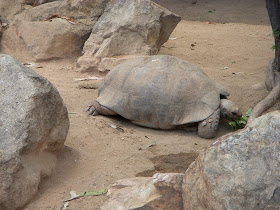This wasn't the first time I'd gone to the San Diego Zoo, but one of the things about the San Diego Zoo is that it's so large and there are so many little trails with exhibits in the most unexpected of places that even with the extended hours during summer it's probably good as impossible to see everything in just one day (and that's not counting the fact that it's not infrequent for certain animals to be taken off exhibit, often the very animals you're most excited to see, as I was to find out). My main goal on this time around was to visit all the areas that I hadn't gotten to go on my first trip there. That sounded simple enough, but one major thing had happened to the zoo that made this more complicated than I had thought it would be.
Never mind that for now though. On my first trip to this zoo I had gone to its Reptile House (which also happens to be the only major exhibition area at the San Diego Zoo that has an actual roof instead of being either netted or open air), but I had completely overlooked the vast area behind it, the Reptile Mesa. We're used to seeing most "reptiles" in glass terrariums, and while the Reptile House has plenty of those, a number of other "reptiles" (even some of the smaller species) get to enjoy large open-air enclosures at the Reptile Mesa, which was really nice to see.
For example, here's a European glass lizard in one of these larger enclosures.
It shares the exhibit with this European pond turtle.
And in the same exhibit is also this ocellated lizard. I quite like the fact that there are a lot of mixed-species exhibits at this zoo.
Here's a fourth species that was in that exhibit. It's some species of tortoise, but I wasn't able to find a sign for this guy.
The next exhibit was more of a desert habitat. I think these are a type of skink, but I've forgotten their exact identification. Lesson learned: remember to take pictures of the signs of animals you can't identify on sight. Also, don't procrastinate for a month when it comes to putting up photos of trips to zoos.
I can probably remember what species of tortoise this is if I try hard enough. Okay, maybe not. It lives in the same enclosure as those maybe-skinks.
Another one of those tortoises with a red-headed agama.
This one is a desert tortoise that lives in a separate exhibit. At least that's the way I remember it. I'm doing a pretty bad job so far.
Next came a positively huge exhibit filled with little lizards. Here's a sungazer on a rock. It was nice and sunny when I came, so all of the "reptiles" were out basking.
More red-headed agamas, this time even more vibrantly colored. It's worthy to note that they had these flowers growing in their exhibit that was attracting hummingbirds. By chance, I happened to see a wild hummingbird the last time I came to the zoo as well.
These are Galapagos tortoises. The zoo has several different subspecies, living side by side (though in separate exhibits).
An Exuma Island iguana, a critically endangered species.
An Anegada ground iguana, another critically endangered species.
And a Cuban iguana, another endangered island-dwelling iguana species!
One of the animals I really wanted to see was the gharial. I'd never seen one before. It had a huge pond with many different species of turtles living alongside. The exhibit was quite a sight to see, but with one problem. I didn't see any gharials no matter how long and hard I looked. There were no signs suggesting that they were off exhibit, but I assume that's what happened.
An Asian forest tortoise.
An African spurrred tortoise.
In spite of all the open-air exhibits here, the Reptile Mesa is not devoid of traditional glass terrariums for some of the other species, especially the amphibians. Here's a Dominican ameiva.
A Uroplatus species, or leaf-tailed gecko.
A golden frog.
A tomato frog. I always remember this species best for its unique defense mechanism. (It secretes a noxious sticky white liquid that can glue the jaws of a predator shut.)
A White's tree frog.
A chuckwalla, known for wedging itself into rock crevices to avoid predators.
A species of viper.
A king snake.
Uh, stumped again.
A rosy boa.
A rattlesnake
Okay, I'm really not certain what these guys are. For reasons unknown, they didn't come with a sign.
A type of monitor lizard.
A matamata turtle.
Finally, a Komodo dragon. This one is actually part of the Reptile House proper, not the Reptile Mesa, but it's still viewable from outside the House itself, so I was able to check it out as I left the area.
































Man, I have got to get back to California one of these days. I haven't seen my friends/relatives who moved out there in years and I haven't even been to San Diego once. Not to mention the totally revised LAMNH and World of Color over in Disney.
ReplyDeleteI enjoyed your zoo post. My favorite animal you posted is probably the red headed agama. I have a thing for reptiles.
ReplyDeleteI also like your dinosaur comics you drew.
Did you see the King Cobra?
ReplyDeleteI vaguely remember seeing it, but I probably didn't get a good picture of it.
ReplyDeleteDid you see the Giant Panda?
ReplyDeleteNot at San Diego, but I've seen them elsewhere.
Delete